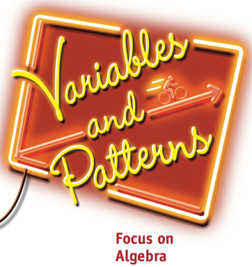Variables and Patterns: Focus on Algebra
Topics
Variables, variable expressions, equations, inequalities; representations of relationships in tables, graphs, equations.
Overview of Changes
This unit was moved from 7th grade, so this is a new unit for 6th grade.
Detailed Description of Changes
The new Common Core State Standards for Mathematics (CCSSM) describe quite specific objectives in algebra for grade six. While some introduction to algebra is done in Prime Time, Let’s be Rational, Covering and Surrounding, and Decimal Ops, the most natural way for CMP3 to respond to those enhanced expectations was to move a revised version of the Variables and Patterns unit from the beginning of grade seven to the end of grade six. The revision for CMP3includes some streamlining of the first three investigations (in part responding to CCSSM requirements that objectives like coordinate graphing be treated in earlier grades and units) and development of new material on order of operations, equivalent expressions, and solving equations that also responds to CCSSM requirements. The study of patterns of change between two variables and how these patterns are captured in verbal contexts, tables, graphs and equations are maintained from CMP2 and are also part of the CCSSM for 6th grade.
Investigation 1: This set of 4 problems begins the development of students’ ability and disposition to find relationships between variables and the representation of those relationships in tables and graphs and ‘stories.’ It focuses almost exclusively on change over time relationships, especially the fundamental connections between distance, rate, and time.
The major changes for CMP3 are:
- Delay of the introduction of the terms ‘independent’ and ‘dependent’ for describing variables until Investigation 2. The rationale for this is that in the typical time and distance situations it doesn’t make much sense to think of distance as a variable that depends on time. The more natural settings for thinking about dependence occur in Investigation 2, where changes in the one variable really do cause changes in another.
- More explicit development of the important relationship between distance, rate, and time in Problem 1.4. This is really only a modest enhancement of issues that have been in this unit all along. It seems a desirable focus of the investigation, since those variables are so important in many mathematical and applied contexts.
Investigation 2: This set of 4 problems continues the development of students’ ability and disposition to find relationships between variables and the representation of those relationships in tables and graphs and ‘stories.’ The focus in this investigation is on cause and effect relationships between dependent and independent variables.
The only significant change in CMP3 is introduction of problem 2.3 on four-quadrant graphing. This is included to satisfy CCSSM objective 6.NS.8.
Investigation 3: This investigation focuses attention on writing symbolic equations for relationships between two variables. It responds directly to the heavy CCSSM emphasis on expressing relationships in symbolic form, and it also deals explicitly with proportionality relationships of the y = mx type involving rates, another CCSSM requirement.
The major changes proposed for this investigation are:
- Introduction of Problem 3.2 to deal explicitly with CCSS 6.RP.2 and 6.RP.3 on proportionality.
- Use tables, graphs and numeric reasoning to find values of the variables.
- Introduction of Problem 3.4 to develop the order of operation conventions that are needed to express quantitative relationships accurately. It addresses CCSSM objectives 6.EE.1, 6.EE.2a, 6.EE.2c, 6.EE.3, and 6.EE.4.
Investigation 4: This investigation is a substantial replacement of the material in CMP2, reworked to address the heavy agenda of CCSSM objectives for equivalent expressions and solving equations and inequalities. It has five problems. While we still encourage students to use calculator- or computer-generated tables and graphs to study relationships and solve problems, we have deleted the explicit directions on how to use those tools. We are assuming that teachers can provide the ‘how to’ instruction without our including it in the student text.
- Problems 4.1 – 4.3 introduce the concept of equivalent expressions in an applied context where students are encouraged to use ‘what makes sense’ reasoning to decide whether two expressions are or are not equivalent. This and the next problem address CCSSM objectives 6.EE.2b, 6.EE.3, and 6.EE.4.
- Problem 4.4 guides students to use of fact families/inverse operations strategies for solving equations. Although the CCSSM introductory essay for grade six mentions solving by operating on both sides of an equation, we do not find that specific guideline in the subsequent objective lists. So we have chosen to settle for informal guess and test strategies and the fact family/inverse operations strategy as being appropriate for students at this stage and with the CMP background on fact families in earlier units.
- Problem 4.5 develops student ability to write and solve simple inequalities per CCSSM requirements. This problem addresses CCSSM objectives 6.EE.5 and 6.EE.7.
| New Investigation | Changes in CMP2 Investigations |
|---|---|
| Investigation 1 Variables, Tables, and Graphs | Investigation 1 is similar to Investigation 1of Variables & Patterns in CMP2. |
| Investigation 2 Analyzing Relationships Among Variables | Investigation 2 is similar to the old Investigation 2 with the addition of four-quadrant graphing |
| Investigation 3 Relating Variables with Equations | Investigation 3 is similar to the old Investigation 3, with an added emphasis on proportional relationships or equations of the form y = mx. |
| Investigation 4 Expressions, Equations, and Inequalities | Investigation 4 is for the most part new with more emphasis on equivalent expressions and solving equations and simple inequalities. For the most part the equations are all of the from ax = b or a + x = b. |
